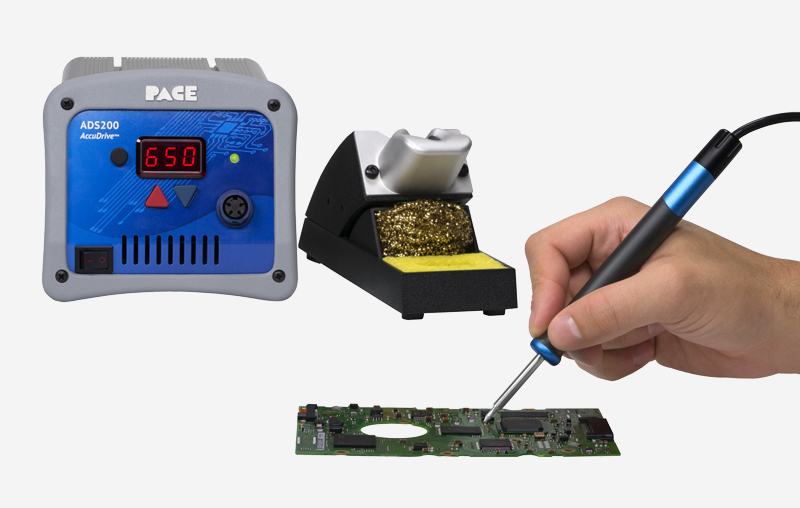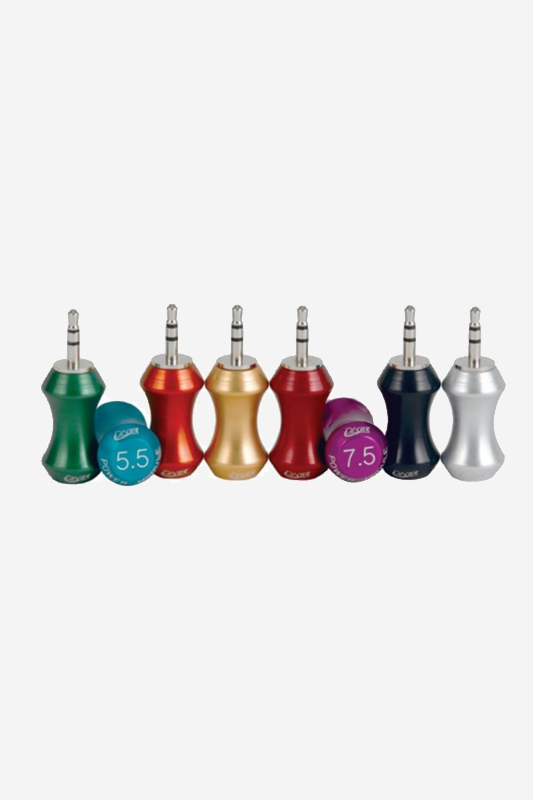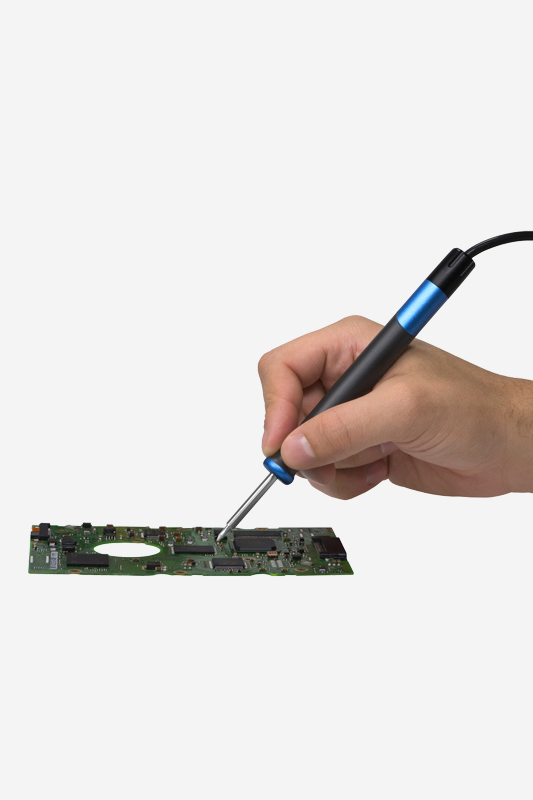The previous part of the article presents the basic problems related to lead-free soldering, as well as ways of solving them. Below we continue the topic, indicating how apparently insignificant details of the construction of soldering stations can significantly affect the efficiency of work with lead-free solders.
THE DEVIL IS IN THE DETAIL
The right type of soldering tip is what makes a significant contribution to the accuracy of the connections and the economic efficiency of the soldering process. The construction of the soldering tip has a decisive influence on these features. It is typically multilayered, with the copper core usually covered with a layer of iron and other metals, and the tip of the blade itself is additionally covered with solder. The copper core provides adequate thermal conductivity, while its iron coating strengthens the blade and prevents the active solder components from dissolving the copper.
Lead-free tips are characterised by a similar, layered structure, but, depending on the manufacturer, the finish of the tip varies. In addition to the iron layer, layers of nickel and chromium are used, ensuring that the tip of the blade is properly covered with solder (lead-free in this case of course).
In the case of the new soldering technology, the proper construction of the soldering tip is a critical factor, due to, among other things, the previously described high concentration of tin in the solder, as well as the more aggressive components of the fluxes and higher soldering temperature. All of these factors can cause erosion of the iron coating and faster deterioration if the tip is badly constructed. The Pace tips are adapted to the requirements of lead-free soldering, with the tips being coated with lead-free soldering binder of Sn99.3%, Cu0.7% composition.
These tips are also characterised by a different design than the typical ones, which results in increased resistance to chemical and mechanical damage (e.g. to scratches). The company’s research shows that the average life expectancy of the tips is several months with the new technology.
HEATS THE TIP, NOT THE FINGERS!
Not visible to the naked eye, but very important, especially for lead-free soldering, is the location of the heating element. It has an influence on two basic parameters of soldering stations – time of temperature stabilization (i.e. the speed of reaching the working temperature by the tip) and temperature inertia (speed of returning the tip temperature to the set value after the tip cools down, e.g. due to contact with the soldering pad). It can be considered that both parameters are all the more important, with the higher temperatures you work.
It is best when the heating element is as close to the soldering point as possible – preferably in the soldering tip itself. Unfortunately, the high level of advancement of such a solution causes that only a few manufacturers decide on it. Pace, in its soldering stations, including the HW series, has integrated the heating element with the soldering tip, thus obtaining a high heat transfer rate. This solution may prove to be a critical factor when making lead-free connections. According to objective test results, stabilization times and temperature inertia are, on average, twice (or more) shorter for heater products integrated in handles than for heater products in handles. Soldering irons equipped with tips integrated in the heater also work at a lower temperature, but still allow for soldering in a shorter time and therefore with higher efficiency.
The integration of the heating element with the tip also has an additional feature that can only be fully felt after a few hours of operation with the soldering iron – the heater heats the tip, not the soldering handle and the fingers of the operator! A factor that is directly related to the precision of temperature stabilization of the blade is also the location of the temperature sensor (thermocouple).
Because what we want to measure is the actual temperature within the soldered area, the situation is analogous to that of a heater – the closer to the tip of the blade, the better. Manufacturers, including Pace, usually use the same sensor location as the heating element – both in the soldering tip or both in the soldering handle. Despite the additional complication of placing the thermocouple in the tip, this type of solution is the most perfect as the thermal energy supplied to the tip is adequate to the received one, so that each soldering point is heated according to its thermal capacity. The entire soldering process, although at a lower temperature than other stations, takes less time, and the appropriate heat flow allows for proper activation of the flux and prevents the formation of faulty connections. In HW series soldering stations the temperature is measured several times per second, which ensures that the station immediately adapts to the current needs, depending on the heat demand of the heated element and the amount of solder used.
POWER MODULES – SMALL AND PERFECT
During the soldering process, especially in industrial conditions, the primary goal should be high quality joints. And although this statement returns in the case of lead-free technology like boomerang, the basic condition for this is precise and reliable temperature control of the soldering tip. However, it may happen that the temperature set by the operator on the assembly line is inappropriate – in particular it may be too high (e.g. set to accelerate the soldering process). However, making connections too fast has a very negative impact on their quality – overheating of the soldering point causes accelerated evaporation of the flux and leads to defects. In addition, if temperature ranges are exceeded in new, lead-free soldering processes, it can lead to damage to the elements themselves and damage to the paths within the soldering points.
The solution to this problem can be twofold. Firstly, many manufacturers of soldering stations equip their products with a temperature lock, so that the process temperature can be easily controlled by e.g. a overseeing specialist. The second possibility is the solution used in the HW series of soldering stations (except for the temperature lock). It is very convenient and consists in using interchangeable power modules. These modules are installed in a socket located at the front of the station. The innovation of this solution is based on the use of different colors of the modules, assigned to the temperature range, so you can always see what temperature the operator is working with. Convenience for the supervisor is obvious – at a glance he can check, even from a distance, whether the operating temperatures of the soldering stations are set correctly. To change the working temperature there is no need to change the tip – only an easily accessible power module is changed. According to Pace distributors, this solution is very popular with customers.
BIGGER STATIONS ON THE HORIZON
The described soldering stations are only a part of a wide range of tools for assembly and disassembly of electronic components by Pace. In the next part of the article we will discuss even more advanced devices – but before that, it is worth noting one more product of this company, dedicated to work with BGA chips. The difficulties of assembly and disassembly of such systems are incomparably greater than in the case of other SMT components. Before soldering BGA, it is necessary to position the unit, and then perform a complex soldering process, which usually uses a hot air stream. It is advisable to use a multi-zone temperature profile, similar to that used in industrial conditions.
Soldering in lead-free technology makes the whole issue even more complicated – the soldering balls, of which there may be even several thousand, must be heated to a higher temperature and at the same time more precisely. The ST-325 PACE station should help to solve this problem, completing the „arsenal” of tools necessary for efficient work with lead-free technology. The station features the ability to use accurate hot air soldering profiles, which is blown directly onto the BGA system, ensuring that the soldering balls melt evenly, and the vacuum gripper, which is included in the standard equipment of the station makes manipulating the BGA system child’s play. In addition, the ST-325 station has been designed in a way that allows for its expansion, depending on the needs of the company – a tripod and software can be purchased, allowing for central control of the heating process and visualization and archiving of data.
IN THE END, A NICE SURPRISE
The question is how much it all costs. Based on objective information from the distributor, one can conclude that advanced soldering tools do not have to be very expensive.
For example, the prices of the Pace tips are slightly higher than those of the classic tips available on the market without an integrated heater, and the soldering station itself, e.g. HW 50, is an expense comparable to that of similar stations of other manufacturers that have a heater in the handle and not in the tip. A nice surprise turns out to be also the price of the ST-325 station. So far, many companies or services, due to lack of tools for work with BGA (professional stations of this type, e.g. PACE TF-1700, cost several hundred thousand zlotys each), have resorted to „guerrilla” methods, using e.g. burners. The ST-325 station, whose cost is a small fraction of the price of TF-1700, should fill this gap, being on the one hand a professional, modular device and at the same time a cheap and accessible to a wide range of users work tool.


